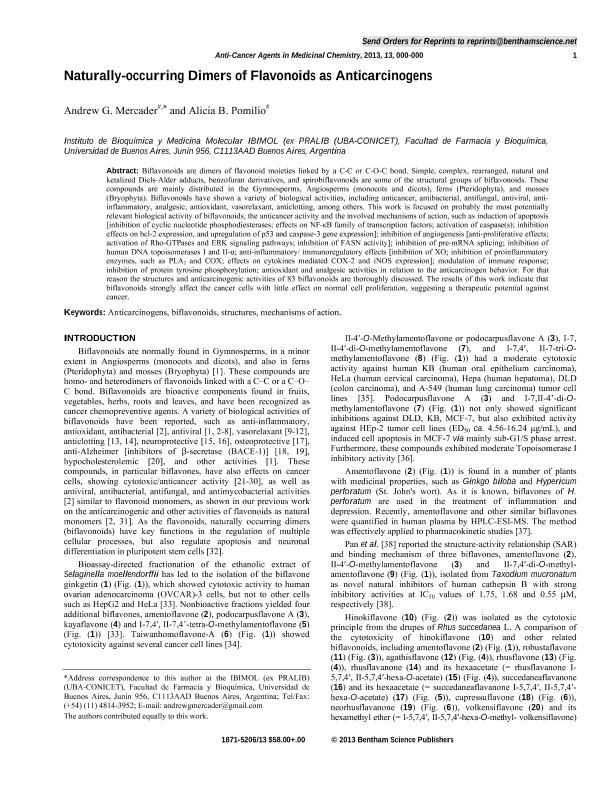Mostrar el registro sencillo del ítem
dc.contributor.author
Mercader, Andrew Gustavo

dc.contributor.author
Pomilio, Alicia Beatriz

dc.date.available
2016-07-18T19:12:59Z
dc.date.issued
2013-10
dc.identifier.citation
Mercader, Andrew Gustavo; Pomilio, Alicia Beatriz; Naturally-occurring Dimers of Flavonoids as Anticarcinogens; Bentham Science Publishers; Anti-cancer Agents In Medicinal Chemistry; 13; 8; 10-2013; 1217-1235
dc.identifier.issn
1871-5206
dc.identifier.uri
http://hdl.handle.net/11336/6573
dc.description.abstract
Biflavonoids are dimers of flavonoid moieties linked by a C-C or C-O-C bond. Simple, complex, rearranged, natural and ketalized Diels-Alder adducts, benzofuran derivatives, and spirobiflavonoids are some of the structural groups of biflavonoids. These compounds are mainly distributed in the Gymnosperms, Angiosperms (monocots and dicots), ferns (Pteridophyta), and mosses (Bryophyta). Biflavonoids have shown a variety of biological activities, including anticancer, antibacterial, antifungal, antiviral, anti-inflammatory, analgesic, antioxidant, vasorelaxant, anticlotting, among others. This work is focused on probably the most potentially relevant biological activity of biflavonoids, the anticancer activity and the involved mechanisms of action, such as induction of apoptosis [inhibition of cyclic nucleotide phosphodiesterases; effects on NF-κB family of transcription factors; activation of caspase(s); inhibition effects on bcl-2 expression, and upregulation of p53 and caspase-3 gene expression]; inhibition of angiogenesis [anti-proliferative effects; activation of Rho-GTPases and ERK signaling pathways; inhibition of FASN activity]; inhibition of pre-mRNA splicing; inhibition of human DNA topoisomerases I and II-α; anti-inflammatory/ immunoregulatory effects [inhibition of XO; inhibition of proinflammatory enzymes, such as PLA2 and COX; effects on cytokines mediated COX-2 and iNOS expression]; modulation of immune response; inhibition of protein tyrosine phosphorylation; antioxidant and analgesic activities in relation to the anticarcinogen behavior. For that reason the structures and anticarcinogenic activities of 83 biflavonoids are thoroughly discussed. The results of this work indicate that biflavonoids strongly affect the cancer cells with little effect on normal cell proliferation, suggesting a therapeutic potential against cancer.
dc.format
application/pdf
dc.language.iso
eng
dc.publisher
Bentham Science Publishers

dc.rights
info:eu-repo/semantics/openAccess
dc.rights.uri
https://creativecommons.org/licenses/by-nc-sa/2.5/ar/
dc.subject
Anticarcinogens
dc.subject
Biflavonoids
dc.subject
Structures
dc.subject
Mechanisms of Action
dc.subject.classification
Química Orgánica

dc.subject.classification
Ciencias Químicas

dc.subject.classification
CIENCIAS NATURALES Y EXACTAS

dc.title
Naturally-occurring Dimers of Flavonoids as Anticarcinogens
dc.type
info:eu-repo/semantics/article
dc.type
info:ar-repo/semantics/artículo
dc.type
info:eu-repo/semantics/publishedVersion
dc.date.updated
2016-03-10T14:15:38Z
dc.journal.volume
13
dc.journal.number
8
dc.journal.pagination
1217-1235
dc.journal.pais
Emiratos Árabes Unidos

dc.journal.ciudad
Sharjah
dc.description.fil
Fil: Mercader, Andrew Gustavo. Consejo Nacional de Investigaciones Científicas y Técnicas. Oficina de Coordinación Administrativa Houssay. Instituto de Bioquímica y Medicina Molecular; Argentina
dc.description.fil
Fil: Pomilio, Alicia Beatriz. Consejo Nacional de Investigaciones Científicas y Técnicas. Oficina de Coordinación Administrativa Houssay. Instituto de Bioquímica y Medicina Molecular; Argentina
dc.journal.title
Anti-cancer Agents In Medicinal Chemistry

dc.relation.alternativeid
info:eu-repo/semantics/altIdentifier/url/http://www.eurekaselect.com/114975/article
dc.relation.alternativeid
info:eu-repo/semantics/altIdentifier/doi/10.2174/18715206113139990300
dc.relation.alternativeid
info:eu-repo/semantics/altIdentifier/doi/http://dx.doi.org/10.2174/18715206113139990300
Archivos asociados
